
Station Name: PORTSMOUTH (Lancs)
[Source: Alan Young]
| Date opened: |
12.11.1849 |
| Location: |
South-east of Station Parade level crossing; behind Lennox Road; railway still in use |
| Company on opening: |
Lancashire & Yorkshire Railway |
| Date closed to passengers: |
7.7.1958 |
| Date closed completely: |
15.7.1963 |
| Company on closing: |
British Railways (London Midland Region) |
| Present state: |
Demolished |
| County: |
Lancashire (now West Yorkshire) – clarified in text |
| OS Grid Ref: |
SD900263 |
| Date of visit: |
October 1977 and July 2016 |
Notes: Although Bradshaw timetables do not include the station until September 1851 it is most likely that Portsmouth (Lancs) opened with the line between Todmorden and Burnley (Thorneybank / Manchester Road) on 12 November 1849; it was not uncommon for intermediate stations to be omitted from timetables.
 For three miles beyond Todmorden town centre there is almost continuous urban and industrial development westwards in the deep, narrow valley of the (Yorkshire) River Calder, coming to an end at Portsmouth. Why the settlement has this name is not known. Books on the origins of national, Yorkshire or Lancashire place-names ignore the village, and the multi-volume A H Smith Place-names of the West Riding of Yorkshire (Cambridge University Press, 1961) dismisses Portsmouth as ‘a modern industrial village’ without offering any etymology. At the time of opening of the Copy Pit route, the Lancashire/West Riding of Yorkshire border passed through the centre of Todmorden, so all of the ‘branch’ stations were in Lancashire; Stansfield Hall, which opened later, was in the West Riding. However, in 1888 the boundary was adjusted to place Todmorden and its urban tentacles entirely within Yorkshire. The new boundary was (and still is) less than a mile west of Portsmouth; nevertheless Portsmouth station continued to be shown in timetables as Portsmouth (Lancs) until it closed, although a ticket has been seen referring to Portsmouth (Yorks) and an image of it is on this page. For three miles beyond Todmorden town centre there is almost continuous urban and industrial development westwards in the deep, narrow valley of the (Yorkshire) River Calder, coming to an end at Portsmouth. Why the settlement has this name is not known. Books on the origins of national, Yorkshire or Lancashire place-names ignore the village, and the multi-volume A H Smith Place-names of the West Riding of Yorkshire (Cambridge University Press, 1961) dismisses Portsmouth as ‘a modern industrial village’ without offering any etymology. At the time of opening of the Copy Pit route, the Lancashire/West Riding of Yorkshire border passed through the centre of Todmorden, so all of the ‘branch’ stations were in Lancashire; Stansfield Hall, which opened later, was in the West Riding. However, in 1888 the boundary was adjusted to place Todmorden and its urban tentacles entirely within Yorkshire. The new boundary was (and still is) less than a mile west of Portsmouth; nevertheless Portsmouth station continued to be shown in timetables as Portsmouth (Lancs) until it closed, although a ticket has been seen referring to Portsmouth (Yorks) and an image of it is on this page.
The station was immediately south-east of the level crossing on Station Parade (formerly Station Road). The main building was on the down (south-west) platform adjacent to the crossing. It was a single-storey timber structure beneath a hipped roof extending a little further back from the platform at its north-west end where the booking hall was situated. A modest porch sheltered the entrance from the level crossing. A waiting room and ladies’ toilet were within this building, but the gentlemen’s toilet was in a small, separate pent-roofed masonry building sited to the south-east. Midway along the up platform there was a timber-built structure containing an enclosed waiting room, possibly porters’ facilities too, of similar style to the building on the opposite platform. The 1894 OS plan does not show a building on the up platform, so it would seem that both this and the down platform building were added together, over 40 years after the station opened and that the main building replaced an earlier structure on the site. The design of these buildings is distinctly late nineteenth / early twentieth century in style, and is similar to structures on the up platforms at the neighbouring Holme and Cornholme stations. A water crane stood at the Todmorden end of the up platform.
Goods facilities were beyond the Burnley end of the station, north-west of the level crossing, consisting of a down side loop and siding, and three loops (one passing through the warehouse) and two sidings on the up side of the running lines.

Local trains routinely called at Portsmouth station. Throughout its life, however, departures were irregularly distributed throughout the day, as seen in the 1863 Bradshaw table below:
Up trains: weekdays
February 1863 |
Destination |
Down trains: weekdays |
Destination |
7.07am |
Todmorden |
8.02am |
Rose Grove |
9.02am |
Todmorden |
9.50am |
Rose Grove |
10.57am |
Todmorden |
11.22am |
Rose Grove |
12.37pm |
Todmorden |
12.17pm |
Burnley |
2.47pm |
Todmorden |
3.12pm |
Burnley |
4.07pm |
Todmorden |
5.22pm * |
Burnley |
7.07pm |
Todmorden |
7.57pm |
Rose Grove |
Up trains: Sunday |
Destination |
Down trains: Sunday ¶ |
Destination ¶ |
8.35am |
Todmorden |
9.04am |
Burnley |
11.03am |
Todmorden |
12.57pm |
Burnley |
8.06pm |
Todmorden |
9.03pm |
Burnley |
Destinations are not always made clear in Bradshaw
* Approximate time. Stops to set down first class passengers only
¶ Summary timetable given with no information on Portsmouth calls. Burnley stated as destination
 Portsmouth Station signal box (originally known as ‘Portsmouth East’) opened in 1878. It was a Saxby & Farmer Type 9 brick box containing an S&F 18-lever frame. In 1895 the box was renamed ‘Portsmouth Station’ and was raised in height to make it an imposing three-storey structure at the same time as receiving a new 20-lever LYR frame. Littleworth (2002) notes that the modified structure was raised in height using Gloucester Wagon Company and Railway Signalling Company old parts to create, in effect, a complete wooden box with ‘locking room’ mounted on an S&F Type 9 brick base. Portsmouth West / Goods box was, at this time, downgraded to a ground frame. For further details of Portsmouth West, see Littleworth (2002) as listed in the Bibliography. The Portsmouth Station box frame was extended to 36 levers in 1905 when the Up Loop was constructed from Copy Pit. Portsmouth Station signal box (originally known as ‘Portsmouth East’) opened in 1878. It was a Saxby & Farmer Type 9 brick box containing an S&F 18-lever frame. In 1895 the box was renamed ‘Portsmouth Station’ and was raised in height to make it an imposing three-storey structure at the same time as receiving a new 20-lever LYR frame. Littleworth (2002) notes that the modified structure was raised in height using Gloucester Wagon Company and Railway Signalling Company old parts to create, in effect, a complete wooden box with ‘locking room’ mounted on an S&F Type 9 brick base. Portsmouth West / Goods box was, at this time, downgraded to a ground frame. For further details of Portsmouth West, see Littleworth (2002) as listed in the Bibliography. The Portsmouth Station box frame was extended to 36 levers in 1905 when the Up Loop was constructed from Copy Pit.
Up trains: weekdays
August 1887 |
Destination |
Down trains: weekdays |
Destination |
7.16am |
Todmorden |
8.21am |
Blackburn via Padiham |
8.18am |
Todmorden |
9.58am |
Blackpool |
11.33am |
Todmorden |
10.56am |
Accrington |
1.08pm |
Todmorden |
12.44pm |
Accrington |
2.59pm |
Todmorden |
1.46pm |
Preston |
4.06pm |
Todmorden |
4.06pm |
Accrington |
6.01pm |
Todmorden |
5.46pm |
Preston |
7.01pm |
Todmorden |
6.56pm |
Accrington |
9.13pm |
Todmorden |
8.51pm |
Preston |
- |
- |
10.11pm |
Accrington |
Up trains: Sunday |
Destination |
Down trains: Sunday |
Destination |
9.00am |
Todmorden |
9.36am |
Blackpool |
11.12am |
Todmorden |
12412pm |
Accrington |
3.05pm |
Todmorden |
3.41pm |
Preston |
4.57pm |
Todmorden |
8.06pm |
Preston |
8.22pm |
Todmorden |
9.11pm |
Blackburn |
Destinations are not always made clear in the timetable
 A further signal box was located 1 mile 144yd north-west of Portsmouth station at Copy Pit, the summit of the line. The first box at Copy Pit was of unknown design, construction and leverage, but in July 1878 a brick-built Saxby & Farmer Type 9 box replaced it, on the up side of the tracks and containing a 24-lever frame; the box was known as ‘Copy Pit Colliery’. This box was itself replaced in 1905/06 with a stone-based LYR Size 7 box with a 32-lever frame, located again on the up side but some distance east of its predecessor, and known as ‘Copy Pit’ (although ‘Copy Pit Siding’ in some documentation). For details of the colliery and a photograph of the box please see the feature on collieries. Click here for further information. A further signal box was located 1 mile 144yd north-west of Portsmouth station at Copy Pit, the summit of the line. The first box at Copy Pit was of unknown design, construction and leverage, but in July 1878 a brick-built Saxby & Farmer Type 9 box replaced it, on the up side of the tracks and containing a 24-lever frame; the box was known as ‘Copy Pit Colliery’. This box was itself replaced in 1905/06 with a stone-based LYR Size 7 box with a 32-lever frame, located again on the up side but some distance east of its predecessor, and known as ‘Copy Pit’ (although ‘Copy Pit Siding’ in some documentation). For details of the colliery and a photograph of the box please see the feature on collieries. Click here for further information.
About half a mile east of Portsmouth station a signal box controlled Stubley Siding (perhaps originally called Brooks & Pickups New Siding). This box opened in 1882 and was a Railway Signalling Company brick-based Size 3 box containing this company’s lever frame. The box closed between 1931 and 1935.
In 1922 the Lancashire & Yorkshire Railway was absorbed by the London & North Western company which now operated Portsmouth station; the following year the LNWR became a constituent of the London Midland & Scottish Railway (LMS). The table below shows departures from Portsmouth in the year of LNWR ownership. At this time the station enjoyed a frequent weekday service but, once again, at irregular intervals. A respectable service was also provided on Sunday.
Up trains: weekdays
July 1922 |
Destination |
Down trains: weekdays |
Destination |
6.58am |
Todmorden |
8.06am |
Rose Grove |
8.19am |
Todmorden |
9.51am |
Rose Grove |
9.45am |
Todmorden |
11.33am Tue & Sat |
Preston |
12.59pm |
Todmorden |
12.41pm |
Preston |
2.33pm Wed & Sat § |
Hull (Riverside) |
1.41pm Sat only |
Rose Grove |
2.48pm Sat only |
Todmorden |
2.41pm |
Rose Grove |
2.59pm |
Todmorden |
4.22pm |
Accrington |
5.25pm |
Todmorden |
5.26pm |
Accrington |
6.43pm |
Todmorden |
6.26pm |
Accrington |
8.49pm |
Todmorden |
8.46pm |
Accrington |
9.45pm |
Todmorden |
9.51pm |
Accrington |
11.05pm Sat only |
Todmorden |
10.41pm Sat only |
Blackburn |
Up trains: Sunday |
Destination |
Down trains: Sunday |
Destination |
8.40am |
Todmorden |
9.51am |
Accrington |
10.30am |
Todmorden |
1.06pm |
Preston |
2.19pm |
Todmorden |
1.12pm † |
Blackpool Central |
4.37pm |
Todmorden |
4.16pm |
Preston |
8.07pm |
Todmorden |
7.56pm |
Blackburn |
- |
- |
9.01pm |
Preston |
§ For Brighouse and beyond ‡ Calls to set down: approximate time † Calls by request: approximate time
It is likely that Portsmouth station was gas lit from an early stage. The LMS installed Sugg gas lamps with the lanterns placed in their preferred fashion at the top of the standard rather than suspended from the feeder pipe.
 At nationalisation in 1948 Portsmouth became part of British Railways’ London Midland Region. Trains still called here on Sunday in summer 1948 but by summer 1950 (see below) they had ceased to do so; weekday departures, however, remained at a respectable frequency, despite the more frequent and regular bus services that passed through the village along the main Todmorden – Burnley road. Competition from road motor services had seen off neighbouring Holme and Cornholme stations before World War 2. At nationalisation in 1948 Portsmouth became part of British Railways’ London Midland Region. Trains still called here on Sunday in summer 1948 but by summer 1950 (see below) they had ceased to do so; weekday departures, however, remained at a respectable frequency, despite the more frequent and regular bus services that passed through the village along the main Todmorden – Burnley road. Competition from road motor services had seen off neighbouring Holme and Cornholme stations before World War 2.
Up trains: weekdays
June 1950 |
Destination |
Down trains: weekdays |
Destination |
6.54am |
Todmorden |
8.21am |
Rose Grove |
8.17am |
Todmorden |
11.31am |
Blackpool Central |
9.24am |
Todmorden |
12.43pm |
Preston |
9.40am |
Todmorden |
1.15pm Sat only |
Accrington |
1.02pm |
Todmorden |
2.44pm |
Blackpool Central |
3.00pm |
Todmorden |
4.24pm |
Accrington |
5.25pm |
Todmorden |
5.29pm |
Accrington |
6.37pm |
Todmorden |
6.25pm |
Blackburn |
9.53pm |
Todmorden |
9.19pm |
Preston |
11.34pm Sat only |
Todmorden |
10.59pm |
Blackburn |
No Sunday trains |
- |
No Sunday trains |
- |
Portsmouth station was closed to passenger traffic on 7 July 1958, leaving Burnley (Manchester Road) as the only intermediate station. The final timetable for Portsmouth is shown below:
Up trains: weekdays
June 1958 |
Destination |
Down trains: weekdays |
Destination |
6.52am Sat only |
Todmorden |
8.20am |
Rose Grove |
8.15am |
Todmorden |
9.31am Sat excepted |
Blackpool Central |
9.37am |
Todmorden |
9.34am Sat only |
Blackpool Central |
1.00pm |
Blackpool Central |
11.30am Sat only |
Blackpool Central |
2.58pm |
Todmorden |
11.40am Sat excepted |
Blackpool Central |
5.24pm |
Todmorden |
12.42pm Sat only |
Preston |
9.44pm |
Todmorden |
2.43pm |
Blackpool Central |
|
|
4.25pm |
Blackburn |
|
|
8.40pm Sat only |
Preston |
|
|
9.18pm |
Manchester Victoria |
|
|
10.58pm Sat only |
Blackburn |
No Sunday trains |
- |
No Sunday trains |
- |

The goods yard at Portsmouth remained in use until 15 July 1963. Regular passenger services through Portsmouth were withdrawn on 1 November 1965.
Returning to the location a little over a mile north-west of Portsmouth, Copy Pit colliery closed c1963 and the colliery sidings and Down Loop (towards Holme Tunnel) had been recovered by 1969. Copy Pit signal box survived until 21 October 1973 when Preston Power Signal Box assumed control of the line.
The building on the down platform at Portsmouth was still in place when John Mann visited and photographed the station in February 1971; it is likely that the up building had already been demolished as he took no photograph of it. Both buildings and the platforms had been removed by autumn 1977.
 On 21 October 1973 Portsmouth Station signal box was downgraded and renamed ‘Portsmouth Level Crossing Frame’ when the Preston Power Signal Box was given control of the line. However, on 14 September 1975 the box at Portsmouth was closed and subsequently demolished. On 21 October 1973 Portsmouth Station signal box was downgraded and renamed ‘Portsmouth Level Crossing Frame’ when the Preston Power Signal Box was given control of the line. However, on 14 September 1975 the box at Portsmouth was closed and subsequently demolished.
Following the restoration of passenger services on the Copy Pit route between Hebden Bridge and Rose Grove in October 1984 there has been a campaign in recent years to reopen a station to serve Portsmouth / Cornholme. Whether the narrow and discontinuous urban area, flanked by almost deserted moorland can provide the critical mass of passengers to justify a new station remains to be seen.
Tickets from Michael Stewart
Click here for a brief history of the Copy Pit line
See also Copy Pit Route Collieries
See other stations on the Copy Pit line: Burnley Manchester Road (1st site), Burnley Manchester Road (2nd), Towneley, Holme, Cornholme, Stansfield Hall, Eastwood & Hebden Bridge (still open) |
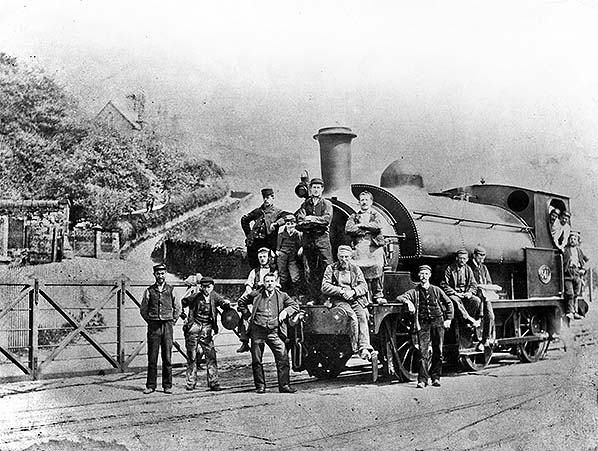 Crew, staff and locomotive pose for the camera on the level crossing at Portsmouth (Lancs) around the turn of the twentieth century. The locomotive is 23 class Aspinall-designed 0-6-0ST No.541. The type was a rebuild of Barton Wright 0-6-0 tender locomotives which had originated in 1876. Rebuild dates are not entirely clear and not least because the date of introduction of the saddle tanks is sometimes confusingly given as 1876 or 1877, in other words the date of introduction of their tender locomotive origins. However, John Aspinall became Chief Mechanical Engineer of the LYR in 1886 and the rebuilding appears to have commenced in 1891. The 23 class totalled no fewer than 230 examples but under LMS auspices withdrawals began in 1926. No.541 went in 1936 and as a result her history is somewhat obscure. At the time of writing only one other photograph of No.541 has been discovered, this being taken on the Rishworth branch. Around half of the class survived into British Railways days with the final example bowing out in December of 1964. One, LYR No.752 which went on to become LMS No.11456, was sold into industrial service with what became the National Coal Board and she has survived into preservation.
Photo from Lancashire & Yorkshire Railway Society and Pennine Horizons Digital Archive collections

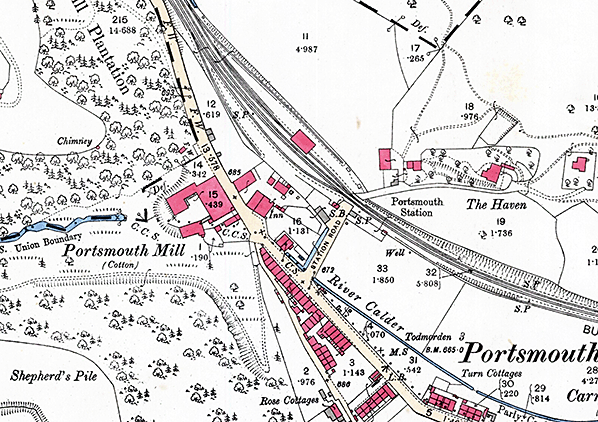
1894 1: 2,500 OS map. Portsmouth station is seen at the stage when only the down (south) platform possesses a building, and this is adjacent to the level crossing. The tinting highlights the goods warehouse in the area of sidings north-west of the passenger station, on the up side of the tracks. On the valley floor, close to the station, are Portsmouth cotton mill and terraced housing, some of it in the form of back-to-backs towards the southern edge of the map extract; the large, detached residences of the Haven and Monkroyd (to its right, not named on this extract) on the hillslope to the east, look attractively situated. The River Calder emerges from a culvert at Station Road.
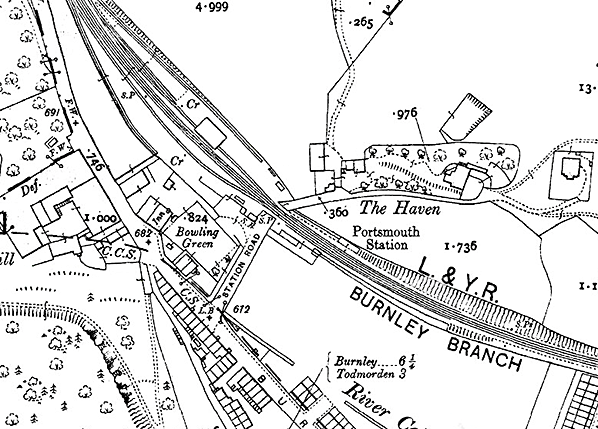
1911 1: 2,500 OS map. For three miles beyond Todmorden town centre there is almost continuous urban and industrial development in the deep, narrow valley of the (Yorkshire) River Calder, coming to an end at Portsmouth. The station is immediately south-east of a level crossing. The main building is on the down (south) platform adjacent to the crossing, and a further small structure is seen to the south-east. The signal box is just beyond the crossing. Midway along the up platform there is a waiting shed which was absent from the 1894 OS map. Goods facilities are beyond the Burnley end of the station, consisting of a down side loop and a siding serving Wilson Bros (bobbin makers) tranship warehouse – the unidentified large building east of the main road - and three loops (one passing through the warehouse) and two sidings on the up side of the running lines. On the valley floor, close to the station, are Portsmouth cotton mill (‘Ill’ of ‘Mill’ is on the extreme left edge) and terraced housing; the large, detached residences of the Haven and Monkroyd (to its right, not named on this extract) on the hillslope to the east, look attractively situated. The River Calder emerges from a culvert at Station Road.
1961 1: 2,500 map. Portsmouth station closed to passengers in 1958 and still handles goods traffic at the time of survey. The station is named and shown to be intact. The goods loops and sidings are in place, but the railway goods warehouse has been removed. Wilson Bros’ tranship shed and siding are shown, west of the main line; it is not known whether Wilson Bros, or their successor Norman Jowett (hauliers), used the building at this time. In 2016 the site of the tranship shed is occupied by housing.
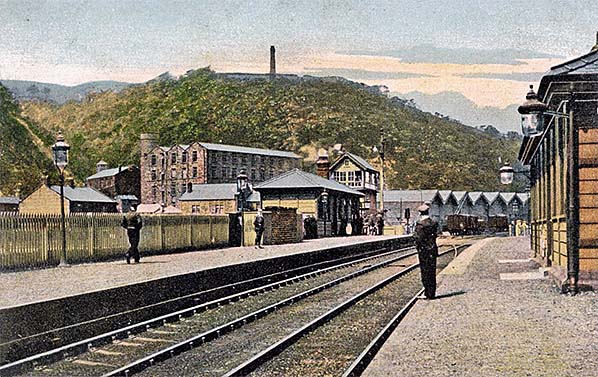
Looking north-west from the up platform of Portsmouth (Lancs) station in the early years of the twentieth century. The similar style of buildings on both platforms will be noted; the main building with booking office is in the up platform building, beside the level crossing. The tall signal box, beyond the crossing, is a Saxby & Farmer Type 9 opened in 1878 (originally known as ‘Portsmouth East’). In 1895 the box was renamed ‘Portsmouth Station’ and was raised in height to create the imposing three-storey structure. The gas lamps with their large glass bowls were a distinctive feature of LYR stations prior to World War 1. Portsmouth cotton mill is seen to the left and land behind rises steeply to Heald Moor. The building with the ‘ridge and furrow’ effect roofing, beyond the goods wagons, is Wilson Bros’ tranship shed. This firm manufactured bobbins in a nearby mill.
Photo from Lancashire & Yorkshire Railway Society and from John Alsop collections
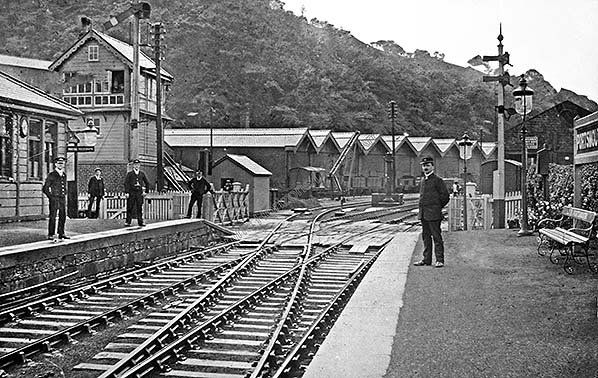
Station staff pose at the north-eastern end of Portsmouth (Lancs) platforms c1910. The large building in the background is the tranship shed of Wilson Bros, bobbin makers of Cornholme.
Photo
from John Mann collection
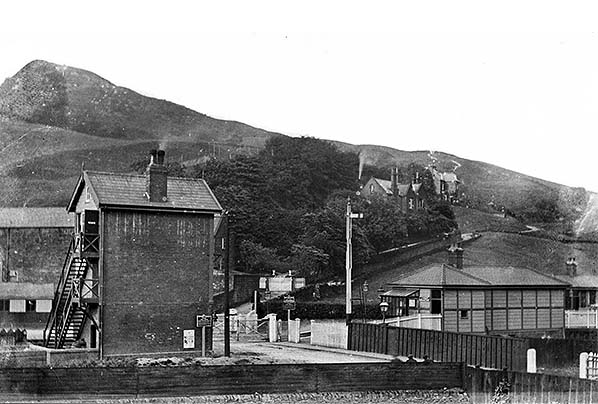
Portsmouth (Lancs) station, looking north-east from an unusual angle. The back of the particularly tall signal box dominates the view. This Saxby & Farmer box was constructed in 1878 then raised in height in 1895. The rear of the main station building, a modest timber structure, is seen just beyond the level crossing; a small enclosed porch provides sheltered access to the booking hall. Station Road slopes upwards, flanked by a couple of elegant houses, after which the moorland begins abruptly.'
Copyright photo from John Alsop collection
Portsmouth (Lancs) station, looking north-west from the up platform c1910. A large crowd of passengers on the down platform waits for a train towards Burnley; most are smartly attired, perhaps travelling further afield to Blackpool for the day. The main station building - a modest timber structure under a hipped roof - and the small stone-built gentlemen’s toilet stand on the down platform. Beyond the crossing is the tall signal box with the tranship shed of Wilson Bros, bobbin makers of Cornholme, in the background.
Copyright photo from John Mann and Pennine Horizons Digital Archive collections
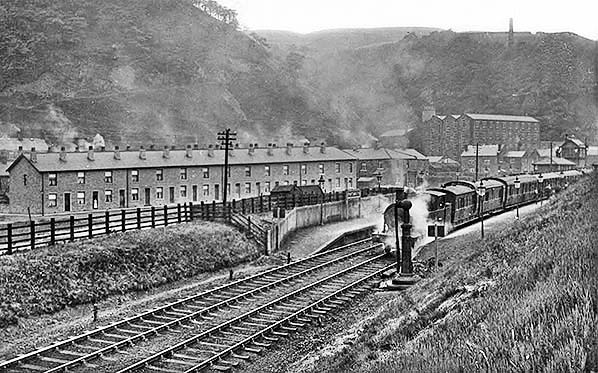
Portsmouth (Lancs) station looking west; the date is before October 1915. A passenger train is standing at the up platform. The water crane, rows of gas lamps and running-in nameboard of the station will be noted. The terraced houses and industry (Portsmouth Mill) are confined to the valley floor, in contrast to the bleak moorlands which rise abruptly in the background. The moors here are relatively narrow, and the Rossendale Valley with its railway between Rawtenstall and Bacup is less than two miles away.
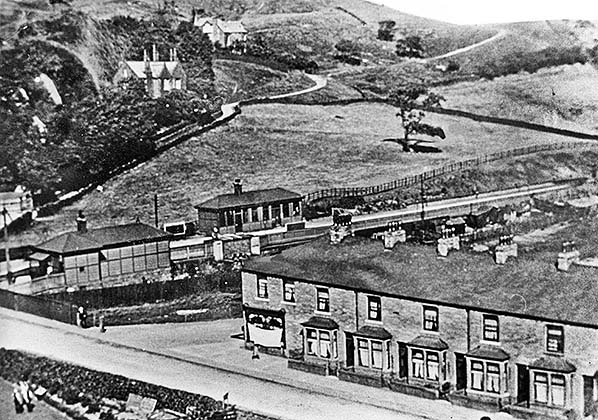
Portsmouth (Lancs) station looking east from Portsmouth cotton mill in 1949. The buildings on both platforms are visible; the rear of the main building on the down platform is far left. On Station Road the terraced houses, lower right, contrast markedly with the substantial villas on the slope
beyond the level crossing.
Photo from Lancashire & Yorkshire Railway Society and Pennine Horizons Digital Archive collections
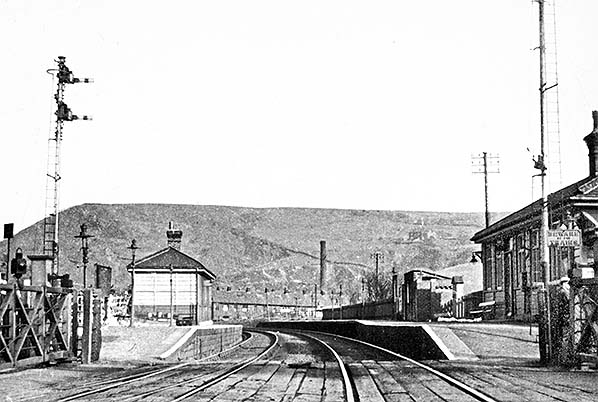
Portsmouth (Lancs) station looking south-east from the level crossing. The date is not provided, but the apparent absence of nameboards suggests that it is shortly after closure to passengers in 1958. The timber, hipped-roofed buildings on each platform are of similar design and are thought to date from around the turn of the nineteenth / twentieth centuries. The gas lamps are of LMS provenance.
Photo
from John Mann and Pennine Horizons Digital Archive collections
A wintertime view of Portsmouth (Lancs) station, looking north-west from the down platform c1959; passenger closure took place in 1958. The station retains the hipped-roofed timber buildings on both platforms and gas lamps; it is not clear if the fixture, far left, is a nameboard. The large building in the background was the tranship shed of Wilson Bros, bobbin makers of Cornholme but latterly it was used by Norman Jowett, hauliers.
Photo from Todmorden Antiquarian Society collection
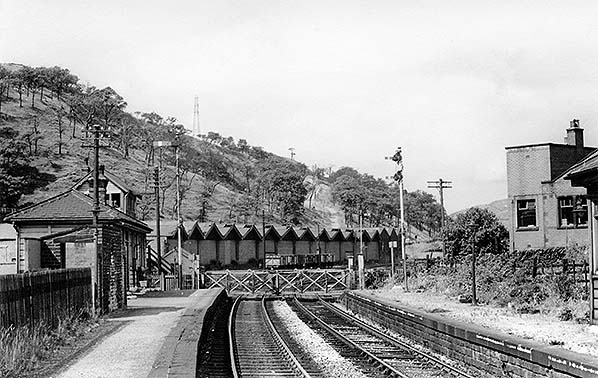
Looking north-east from the down platform of Portsmouth (Lancs) station in 1959, approximately a year after it closed to passengers. The small pent-roofed building in the foreground is the gents’ toilet and beyond is the main station building. Redundant gas lamps still adorn the platform.
Photo by H B Priestley
Click here for Portsmouth Station Gallery 2:
1960 - July 2016
| Last
updated: Monday, 22-May-2017 11:47:11 CEST |
© 1998-2016 Disused Stations
| |





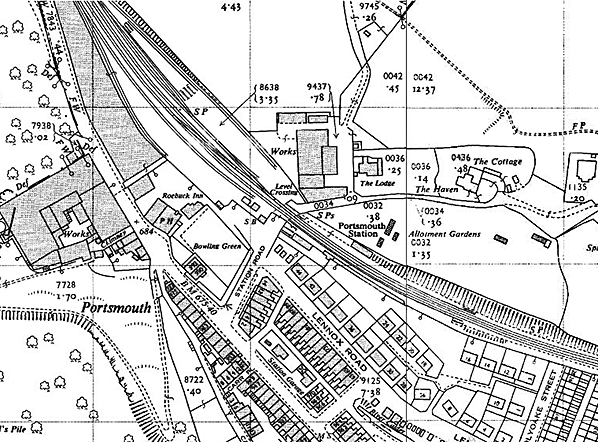



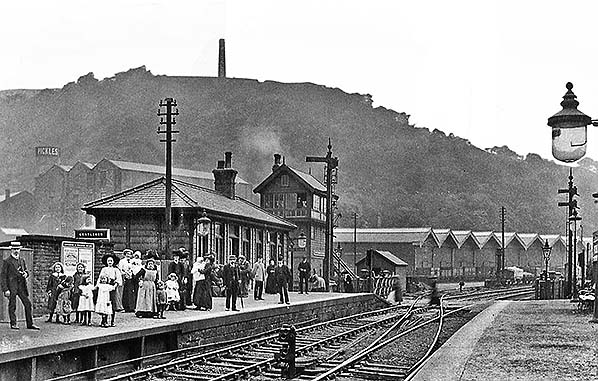



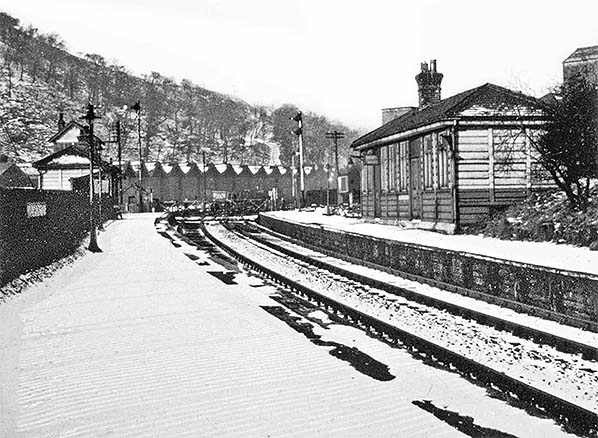

 For three miles beyond Todmorden town centre there is almost continuous urban and industrial development westwards in the deep, narrow valley of the (Yorkshire) River Calder, coming to an end at Portsmouth. Why the settlement has this name is not known. Books on the origins of national, Yorkshire or Lancashire place-names ignore the village, and the multi-volume A H Smith Place-names of the West Riding of Yorkshire (Cambridge University Press, 1961) dismisses Portsmouth as ‘a modern industrial village’ without offering any etymology. At the time of opening of the Copy Pit route, the Lancashire/West Riding of Yorkshire border passed through the centre of Todmorden, so all of the ‘branch’ stations were in Lancashire; Stansfield Hall, which opened later, was in the West Riding. However, in 1888 the boundary was adjusted to place Todmorden and its urban tentacles entirely within Yorkshire. The new boundary was (and still is) less than a mile west of Portsmouth; nevertheless Portsmouth station continued to be shown in timetables as Portsmouth (Lancs) until it closed, although a ticket has been seen referring to Portsmouth (Yorks) and an image of it is on this page.
For three miles beyond Todmorden town centre there is almost continuous urban and industrial development westwards in the deep, narrow valley of the (Yorkshire) River Calder, coming to an end at Portsmouth. Why the settlement has this name is not known. Books on the origins of national, Yorkshire or Lancashire place-names ignore the village, and the multi-volume A H Smith Place-names of the West Riding of Yorkshire (Cambridge University Press, 1961) dismisses Portsmouth as ‘a modern industrial village’ without offering any etymology. At the time of opening of the Copy Pit route, the Lancashire/West Riding of Yorkshire border passed through the centre of Todmorden, so all of the ‘branch’ stations were in Lancashire; Stansfield Hall, which opened later, was in the West Riding. However, in 1888 the boundary was adjusted to place Todmorden and its urban tentacles entirely within Yorkshire. The new boundary was (and still is) less than a mile west of Portsmouth; nevertheless Portsmouth station continued to be shown in timetables as Portsmouth (Lancs) until it closed, although a ticket has been seen referring to Portsmouth (Yorks) and an image of it is on this page.
 Portsmouth Station signal box (originally known as ‘Portsmouth East’) opened in 1878. It was a Saxby & Farmer Type 9 brick box containing an S&F 18-lever frame. In 1895 the box was renamed ‘Portsmouth Station’ and was raised in height to make it an imposing three-storey structure at the same time as receiving a new 20-lever LYR frame. Littleworth (2002) notes that the modified structure was raised in height using Gloucester Wagon Company and Railway Signalling Company old parts to create, in effect, a complete wooden box with ‘locking room’ mounted on an S&F Type 9 brick base. Portsmouth West / Goods box was, at this time, downgraded to a ground frame. For further details of Portsmouth West, see Littleworth (2002) as listed in the Bibliography. The Portsmouth Station box frame was extended to 36 levers in 1905 when the Up Loop was constructed from Copy Pit.
Portsmouth Station signal box (originally known as ‘Portsmouth East’) opened in 1878. It was a Saxby & Farmer Type 9 brick box containing an S&F 18-lever frame. In 1895 the box was renamed ‘Portsmouth Station’ and was raised in height to make it an imposing three-storey structure at the same time as receiving a new 20-lever LYR frame. Littleworth (2002) notes that the modified structure was raised in height using Gloucester Wagon Company and Railway Signalling Company old parts to create, in effect, a complete wooden box with ‘locking room’ mounted on an S&F Type 9 brick base. Portsmouth West / Goods box was, at this time, downgraded to a ground frame. For further details of Portsmouth West, see Littleworth (2002) as listed in the Bibliography. The Portsmouth Station box frame was extended to 36 levers in 1905 when the Up Loop was constructed from Copy Pit. A further signal box was located 1 mile 144yd north-west of Portsmouth station at Copy Pit, the summit of the line. The first box at Copy Pit was of unknown design, construction and leverage, but in July 1878 a brick-built Saxby & Farmer Type 9 box replaced it, on the up side of the tracks and containing a 24-lever frame; the box was known as ‘Copy Pit Colliery’. This box was itself replaced in 1905/06 with a stone-based LYR Size 7 box with a 32-lever frame, located again on the up side but some distance east of its predecessor, and known as ‘Copy Pit’ (although ‘Copy Pit Siding’ in some documentation). For details of the colliery and a photograph of the box please see the feature on collieries. Click here for further information.
A further signal box was located 1 mile 144yd north-west of Portsmouth station at Copy Pit, the summit of the line. The first box at Copy Pit was of unknown design, construction and leverage, but in July 1878 a brick-built Saxby & Farmer Type 9 box replaced it, on the up side of the tracks and containing a 24-lever frame; the box was known as ‘Copy Pit Colliery’. This box was itself replaced in 1905/06 with a stone-based LYR Size 7 box with a 32-lever frame, located again on the up side but some distance east of its predecessor, and known as ‘Copy Pit’ (although ‘Copy Pit Siding’ in some documentation). For details of the colliery and a photograph of the box please see the feature on collieries. Click here for further information.  At nationalisation in 1948 Portsmouth became part of British Railways’ London Midland Region. Trains still called here on Sunday in summer 1948 but by summer 1950 (see below) they had ceased to do so; weekday departures, however, remained at a respectable frequency, despite the more frequent and regular bus services that passed through the village along the main Todmorden – Burnley road. Competition from road motor services had seen off neighbouring Holme and Cornholme stations before World War 2.
At nationalisation in 1948 Portsmouth became part of British Railways’ London Midland Region. Trains still called here on Sunday in summer 1948 but by summer 1950 (see below) they had ceased to do so; weekday departures, however, remained at a respectable frequency, despite the more frequent and regular bus services that passed through the village along the main Todmorden – Burnley road. Competition from road motor services had seen off neighbouring Holme and Cornholme stations before World War 2.
 On 21 October 1973 Portsmouth Station signal box was downgraded and renamed ‘Portsmouth Level Crossing Frame’ when the Preston Power Signal Box was given control of the line. However, on 14 September 1975 the box at Portsmouth was closed and subsequently demolished.
On 21 October 1973 Portsmouth Station signal box was downgraded and renamed ‘Portsmouth Level Crossing Frame’ when the Preston Power Signal Box was given control of the line. However, on 14 September 1975 the box at Portsmouth was closed and subsequently demolished.
 Home Page
Home Page